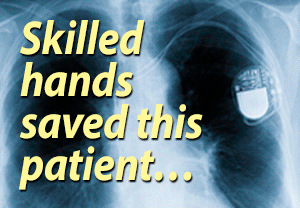 pacemaker syndrome
pacemaker syndrome
- by karma
- 2008-06-02 02:06:29
- Checkups & Settings
- 2321 views
- 4 comments
could anyone tell me what pacemaker syndrome is, the doctor mentioned it in passing but didn't go into detail. thanks
4 Comments
PM Syndrom
by MHCHAMPION - 2008-06-02 06:06:55
Smitty,
Thanks for answering this person's question as it was very enlightening to me as well.
This site is wonderful!
Margaret
Thanks Smitty!
by ElectricFrank - 2008-06-03 01:06:20
I thought the pacemaker syndrome was some sort of ritual dance we did where we go round and round with our cardiologist and EP. Fooy.
frank
Pacemaker syndrome
by vtlaney - 2008-07-06 08:07:38
Smitty...you are amazing and what a wealth of information you have...am courious if you know anything about diastolic dysfunction in relation to the pm and if that could affect the pumping causing the pmt...I feel so inadequate when it comes to the pm and am trying so hard to learn as much as I can. Have only had my pm since 6-4-08...thanks to everyone....vtlaney
You know you're wired when...
You make store alarms beep.
Member Quotes
Hi, I am 47 and have had a pacemaker for 7 months and Im doing great with it.

.png)



Pacemaker Syndrome
by SMITTY - 2008-06-02 03:06:18
Hello Karma,
Below is something from several articles I put together sometime ago on this subject which I have found helps me understand pacemaker syndrome. I hope it helps you.
Pacemaker Syndrome: Rarely, pacemakers can make some symptoms better but cause new symptoms. People with pacemakers may no longer have fainting spells, but they may feel tired and listless. They may notice pounding in the neck or chest and may generally not feel as good during daily activities as they once did. This is called pacemaker syndrome.
A simple description of what is happening with pacemaker syndrome, think of the heart as two hollow balls. The ball on the left represents the atrium and the one on the right represents the ventricle. There are two tubes on each ball. One is for filling the balls with a liquid and the other is for letting the liquid flow from the ball. Where each tube is attached to the ball is a simple flapper valve. When a small amount of pressure is applied to the one side of this valve it opens and lets liquid flow. Apply a small amount of pressure to the opposite side of that valve and it closes stopping the flow of the liquid.
For the sake of this demonstration, we will say the left hand ball is full of liquid. Now visualize taking your finger and pressing on this ball. This causes pressure to be applied to the valve on the outlet tube of that ball to open thereby letting liquid flow from the ball on left into the ball on the right. Then, with your finger press on the right hand ball and this pressure causes valve between this ball and the one on the left to close tightly and also causes the liquid in this ball to flow out.
Now visualize pressing the ball on the left hand and on the right hand ball at almost the same instant, but you hesitate a few thousandths of a second before, but you press on the right hand ball before all the liquid in the ball on the left has time to move into the right hand ball. Some liquid will pass from the left hand ball, but because pressure was applied to the right hand ball before the transfer of liquid is complete, the valve between the two balls is closed and you have only a partially filled right hand ball.
Proper pumping by the heart depends on a number of things. It needs good blood flow from the veins, a proper rate of beating, and heart muscle that squeezes well. The heart also needs to squeeze in the correct pattern. Each heartbeat should start with squeezing (contraction) of the upper heart chambers (atria). A short pause is then followed by contraction of the lower heart chambers (ventricles). If the pattern is changed even slightly, the heart does not pump efficiently and this can affect how you feel.
Artificial pacemakers may help the ventricles, the atria, or both to contract (squeeze) at the proper time. They are designed to follow the heart's normal rhythm. They can be fine-tuned to maintain the normal pattern of the heartbeat. However, sometimes a pacemaker impulse may travel backward. This may cause the atria to contract at the wrong time. Also, a pacemaker that fires at a constant rate may be just fine for someone at rest but may not work well for exercise. Either of these situations may cause symptoms.
What are the symptoms? You may feel tired and listless. You may notice a pounding in your neck or chest. You may generally not feel as good during daily activities as you used to.
How is it diagnosed? Your healthcare provider will ask about your symptoms and may examine you, including a check of your pulse. You may have an electrocardiogram (EKG or ECG) or a 24-hour tape recording of the heart's electrical activity.
How is it treated? Pacemakers can be reprogrammed to change their pattern. Your healthcare provider may change heart rates, strength of impulse, and the small built-in pauses that are part of heart contraction. Most of the symptoms can be made better by changing these settings. Several tries with different settings may be necessary. Less commonly, the pacemaker may need to be replaced with one that can pace both the atria and ventricles, or with a pacemaker that can respond to exercise by increasing its beating rate during exercise.
How long will the effects last? With the right pacemaker and the right adjustments, almost all pacemaker syndromes can be treated or prevented.
Smitty